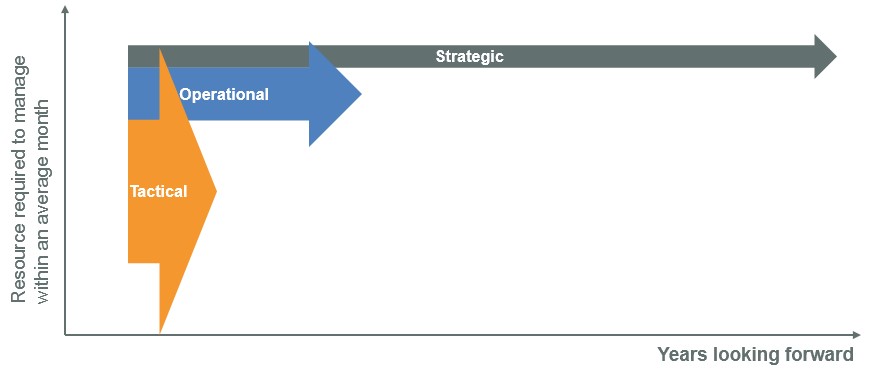Workforce planning doesn’t just mean HR analytics
A definition of workforce planning, including strategic and operational workforce planning.
People often say one thing but really mean something else. They say our “Vision” but mean “Goal”. For instance, our “vision is to be in the top quarter of x”. A noble goal, for sure. But not a vision. And so it is equally with Workforce Planning.
All too often, what is meant is an overview of the workforce demographics. The kinds of questions referred to often include:
- How many people do we have for a given age?
- What is the gender or diversity split?
- How many open posts are there?
But this is not workforce planning, it is HR analytics.

Workforce planning is about the numbers of “workers” (be they perm or temp; full time or part) required for each time period (by year, month, week…) and what the gap is given the current headcount, given likely attrition and the required skills sets/competencies. I.e. it is temporal in nature. It requires planning, gap analysis, and tracking of progress.
Two main points of view here:
- We like to think of workforce planning across three time horizons:
- Strategic/Multi-year
- Operational/In year
- Tactical/within the window of current recruitment and staff-turnover churn/replacement cycles
- We think a better term would be “Workforce Management” than “Workforce Planning”:
- To start with, yes, it is about having a robust plan. A necessary but insufficient requirement
- It is about knowing the gap between actuals and plan. It is about knowing why there is a gap. What is the root cause? Is it because you didn’t recruit the number in the plan? Is churn highly than assumed? Has the plan has changed?…Only when you know why you are off plan in any given area are in you in position do actually do something about it
- It is about knowing how the plan is changing and being able to adapt to change in flight. It is about communication. Everyone knowing the state of play. Everyone being clear what they need to do and how well they are doing. This is management, pure and simple.
Three time horizons of workforce planning
The below figure highlights the relative amount of effort required at a point of time vs the “number of years forward looking”. At most points in time, the Tactical Management absorbs the majority of time, but only has a relatively short horizon.

Strategic Workforce Planning
This is the multi-year stuff. It is related to helping and even driving the overall strategy. If people are your most important asset, then how are you going to make them your differentiator to “win” in future years?
Example of strategic planning include:
- Looking at the number of Doctors who are going to retire in 5-10 years. Spotting that there was a large intake nationally 20 years ago, that the pipeline of existing “talent” and student graduates isn’t large enough to plug the gap. This is where governments need to understand they need to increase the intake of students. Another example of this is the number of nuclear scientists with respect to the nuclear power industry or experienced mine engineers in parts of Australia. They are the sorts of trends that are hard to spot with a “In-Year” or even “In-decade” perspective.
- Thinking through the core activities which will strategically differentiate you the competition. As one strategy professor said (forgotten who, my apologies), “Strategy is about answering two questions. 1) Where to compete? 2) How you are going to win?” Knowing how you are going to win is about knowing what you are going to do better. That is the combination of activities and competence (not all competence is people, it might be having a more dynamic supply chain with a superior footprint or a unique technology,…but a great deal of it is, and it is human competence is always needed to support any physical/technological one in any event)
- A major transformation, e.g. post-merger; change in legislation, process and IT within a Govt department. Questions are, how many are required in the “New World” state, where and doing what? (This is where the link to OD is so strong. Watch out for my upcoming blog on the differences between the two). I had one government client that was introducing a totally new way of working (new rules, IT, goals.…everything). The change was so big that all front line staff needed weeks of training (was it 2,3, or 4 weeks? One of the many drivers). There was the migration of data. System exceptions resulting in more work (one exception resulted in 360,000 man-days of effort over 5-years alone, or 340 extra staff alone. This was totally off plan). The fundamental question as to how efficient the new vs old world would be and therefore how many people were needed each month for the next 5-years. There was a bulge required. Moving from 12,000 people to well over 16,000 and then down to 8,700. This wasn’t feasible. So the workforce planning drivers, and the quantification of the impact of those drivers ended up determining a great deal of the actual departmental strategy.
Operational planning & management:
Think budgeting. Think detailed operational business plans and the workforce part of that. Think through core assumptions such as attrition, training to plug skills gaps, which recruitment channels
Examples of Operational workforce planning
- Moving case workload from one business unit to another
- Setting the goals for recruitment and headcount for the year
Tactical management
This is the reactive. This is the day-to-day. It is reacting to unforeseen changes. A key member of staff leaves. Attrition suddenly jumps. Candidates dry up.
We call it “Tactical management”, because it is the execution of both the strategic and operational plans. It is knowing which recruitment channels are working well and which aren’t. It is being able to better predict attrition from sources such as Fast Feedback surveys.
Tactical workforce management gets the least amount of air time but takes the most real time and what we do in reality is what counts at the end of the day.